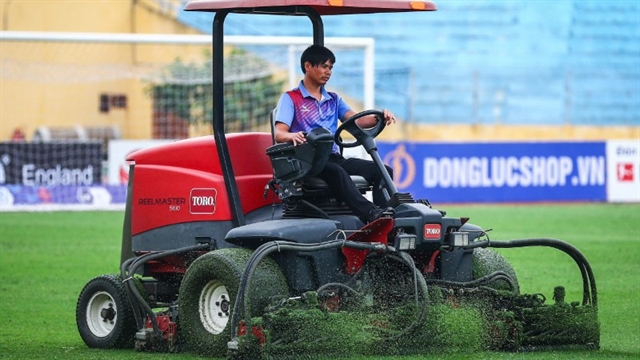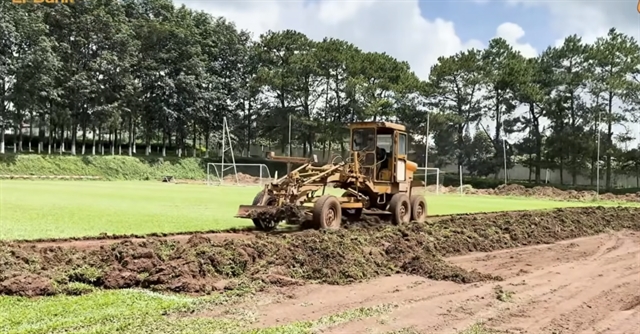A quality pitch not only ensures optimal playing conditions but also directly impacts players' physical well-being, tactical execution, and the overall quality of each match.

A worker is renovating the grass surface of the Hàng Đẫy Stadium in Hà Nội. Investing in renovating and upgrading the grass surface is a necessary requirement for professional football. Photo nhandan.vn
Football
HÀ NỘI The quality of pitches at Vietnamese football clubs is a pressing issue that hinders tactical deployment, diminishes professional standards and may lead to serious player injuries.
This challenge is a significant 'bottleneck' that must be addressed to enhance match professionalism and promote the advancement of national football.
A quality pitch not only ensures optimal playing conditions but also directly impacts players' physical well-being, tactical execution and the overall quality of each match.
Additionally, the condition of the turf is viewed as the 'face' of a football club, reflecting the professionalism of the national championship.
In Việt Nam, poor pitch conditions have persisted for many seasons. The sight of scorched grass, uneven surfaces and gravel in stadiums like Vinh, Thanh Hóa, Hà Tĩnh and Quy Nhơn has become commonplace. Despite being a long-standing issue, it has not been adequately resolved over the years.
Foreign coaches working in Việt Nam often express concerns about substandard field conditions, which directly affect tactical implementation. This has contributed to some coaches failing to leave their professional mark, with instances of early departures due to frustration.
Notable figures such as former Hà Nội FC coach Daiki Iwamasa and Thể Công Viettel's Velizar Popov have repeatedly criticised the quality of V.League 1 pitches, warning that it jeopardises the sustainable development of Vietnamese football.
Stuart McCheyne, who previously managed field maintenance for top European clubs like Arsenal, Ajax and AC Milan, noted that Vietnamese clubs have not prioritised pitch care.
"Grass plays a crucial role in modern football. During my time in Việt Nam, I found the pitch quality in V.League 1 to be quite low," McCheyne said.
McCheyne attributed this situation to a lack of seriousness among some club leaders regarding field maintenance.
Additionally, Việt Nam lacks specialised equipment and a skilled team of technicians knowledgeable about turf management. For Vietnamese football to develop sustainably and reach higher levels, improving playing surfaces must be a priority.
While not the sole cause of injuries, approximately 30 per cent of serious player injuries are linked to poor pitch conditions. Regular exposure to substandard fields can lead to strain on players' backs, knees and ankles.
During jumping and aerial confrontations, landing on uneven surfaces heightens the risk of ligament tears or meniscus damage, which can have severe long-term consequences.
Lê Tuệ Đăng, director of the Nha Trang Sports Biomedical Centre and former doctor for the Vietnamese U23 team, said that poor-quality pitches place undue stress on players' bodies, raising the likelihood of chronic injuries.
Currently, aside from the Pleiku Stadium, managed directly by Hoàng Anh Gia Lai Club, most V.League 1 stadiums are owned and managed by local sports authorities, classified as public assets.
This arrangement creates barriers for clubs seeking to renovate pitches or upgrade infrastructure, as all changes must undergo bureaucratic procedures and depend on state funding.

Hoàng Anh Gia Lai recently replaced the carpet grass of the Pleiku Stadium with grass with needle-like leaves.
Ultimately, the key lies in the clubs' specific plans and financial resources. Few clubs in Việt Nam actively propose stadium upgrades to local culture and sports departments, primarily due to financial constraints, as many teams rely on provincial budgets.
Many club leaders have not prioritised pitch improvements, while some teams invest heavily in players, the condition of the grass remains neglected, as few have the means to establish a dedicated maintenance team.
Hoàng Anh Gia Lai recently replaced the carpet grass at the Pleiku Stadium with grass with needle-like leaves after 15 years of use. This is a significant step towards enhancing training quality in preparation for the new season, providing a playing surface more suited to the team's style.
To innovate football thinking in Việt Nam, there must be a focus on infrastructure, particularly pitch quality. When grass is maintained to a high standard, players benefit from an ideal environment for modern tactics and coaches can implement cohesive playing styles. This, in turn, will elevate player performance and lay a solid foundation for the development of national teams. VNS